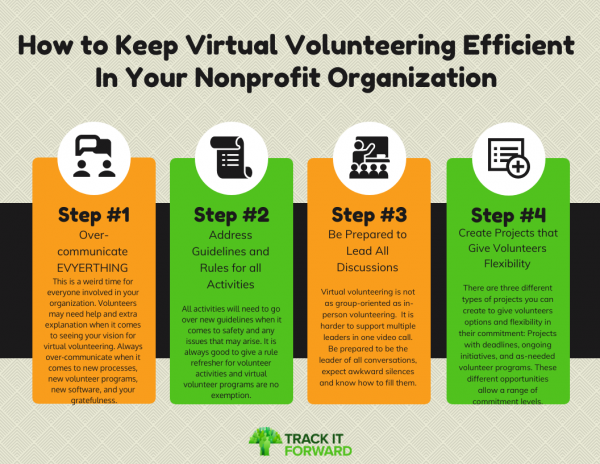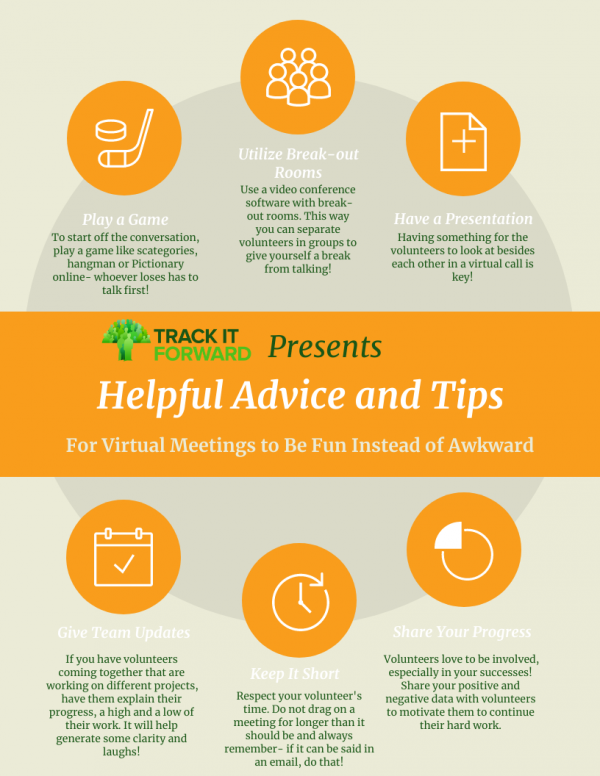As we enter this world of mask-wearing times it seems that it is going to be a battle of making creative events virtually for your organization. Virtual volunteering is a phrase that most of us have not used before, but now it is a part of our everyday lives.
We gathered all of the resources that are going to help you plan virtual events, keep virtual volunteering interesting, maintain a sense of community in a virtual environment, and still be efficient for your organization with virtual volunteering.
When it comes to virtual volunteering, volunteer coordinators, managers, and nonprofits in general are going to have to be a little more creative than before to engage volunteers during COVID-19. Volunteers may be a bit hesitant to come back to volunteer in-person right away, so virtual volunteering is the answer.
Some organizations are able to replace their normal volunteer operations with virtual ones, which is great. If your organization has a volunteer program that provides tutoring, this can be done virtually with a few new guidelines and virtual training in place.
But, we know some organizations really cannot replace their regular volunteering with virtual activities. Like animal shelters, for example, you cannot walk a dog virtually. But, there are still some things that these organizations can ask volunteers to do in a virtual environment. It is time for volunteer coordinators and volunteers to put their creative hats on and work on innovating their volunteer programs to work virtually.

Transitioning to Virtual Volunteering
The first step into having a successful virtual volunteering program is to rethink the different purposes that your organization is hoping to serve. This comes down to the bare minimal mission and values.
Then, think of how you can serve these values in an online community or in a socially responsible way during COVID-19. This is the hard part. Remember that if you are hoping to have virtual volunteering, you should also include “at-home” projects that can grant volunteer hours as well due to some people not having access to a computer or certain software.
To recap, there are three different types of volunteer initiatives you can plan during COVID-19: virtual volunteering, at home volunteering projects, and social distance events. This last one is tricky because some people may not be comfortable with this yet- so be careful and be prepared to provide sanitizer, masks, and a cautious plan of action when it comes to cleaning procedures and monitoring social distancing.
If you are having trouble coming up with ideas for volunteer initiatives with these limitations, maybe it is time to focus more so on your organization itself. This is a great time to take a step back and focus on the behind the scenes part of your organization - and involve your volunteers.
When people are indoors and you find yourself struggling with virtual volunteer work, start to focus on rebranding your organization. Or maybe come up with a stronger social media presence, or refresh your email strategies. Think of all the things you have put on the back burner for your organization and work on them now!
Next, ask your volunteers what other skills they have. You may have a college student volunteer who is studying marketing, or an adult volunteer who loves building budgets, or even an interior designer who would be a great hand in redecorating your in-person office or location if you have one. Reach out to your volunteers, see who would like to help in some more behind the scenes jobs. This is a whole new way to virtually incorporate your volunteers and it will still be effective for your organization.
Virtual Volunteering Tips for the Organization
As you create virtual volunteering opportunities in your organization, it is important to consider how your organization’s normal data collecting, reporting, and categorization of tasks may change.
For example, when you have in-person volunteering you may have a sign-in sheet where you gather the names of everyone who helped at the event. You cannot have this anymore, and you may not be able to have this for a while- so how will you keep track of your virtual volunteers?
Or, in a meeting, you may have a calendar that you read out loud showing the next week or month’s events. You cannot have the ease of a regular in-person meeting anymore or even the opportunity to have events that people sign up for, so how will you create opportunities for volunteers to gain hours if there are no events?
Or, you may have meetings with different committees within your organization that work on different projects. These committees may not be able to work on their projects now, and there may be new projects and new committees that need to be formed. How will you reorganize your volunteers into groups or committees with there being smaller projects?
Here are some of our tips to help you handle the new categorization of your organization.
Administrative Tips for Setting Up Virtual Volunteering
Once you figure out how you are going to do virtual activities and different programs for your volunteers, figure out how many volunteers you will need for each task/ project. This way, you do not have one volunteer doing the work that 10 can split up or vice versa. It is much easier at an in-person event to see how many people will be needed or to have someone float around, but this is not the case with virtual volunteering.
- Have an online self-service software, where volunteers can log their own hours. This helps if they create their own schedule to work from home on projects. It also is a great tool to have when you start to move forward with other volunteer initiatives.
- Create an email explaining how the different virtual volunteer methods that are coming and how the process for signing up for volunteering is changing. Then, do a large online video conference going through the same information and having people ask questions about each project or opportunity.
- After this, separate the volunteers into breakout groups in which they will work with from now on, virtually. (You can separate this into different categories, for example, one group can be one member from each subcategory project of volunteering, or each subcategory of virtual volunteering can be their own group)
- If you are having virtual volunteers work directly with clients online - have a webinar or teaching session to go over possible scenarios and the best ways to approach them if they come up in a virtual volunteering session.
- Have weekly or monthly check-ins where people give a “report” on what they have done volunteering wise. This will help everyone understand what the organization is doing. It will take place of a regular meeting. Ask your volunteers to have fun with it! Involve photos, videos, presentations, quizzes, and games.
- It is also important that you talk about more than just volunteering in these meetings. Start by asking everyone something they have been doing besides volunteering. (What Netflix shows have you been watching? Do you have any recommendations?)
Suggestions for Virtual Volunteering Activities
Each nonprofit is so different, it is hard to come up with suggestions for every niche in nonprofits, but think of how each activity could be related to your organization and maybe you can find a new virtual volunteer program idea!
Administrative Virtual Volunteering
This is for the organizations that are going to have volunteers help them with the organization and the business operations. Here are some ideas of what volunteers can do virtually to help you.
- Set up an email campaign to raise awareness for your organization
- Work on social media for your organization - create social media profiles, engage with the community on your behalf, create graphics and posts
- Design or Re-design your website
- Organize donors or spreadsheets that track business operations
- Recruit volunteers for lacking projects
Fundraising Virtual Volunteering
These opportunities work well for people who rely on donations and funding from in-person events or recruiting.
- If your organization requires research for action- get your volunteers involved in this research or grant writing process
- Fundraising Phone Calls
- Create a donation center for non-monetary items your organization can donate instead of buying
- Ask local businesses to donate items for an auction to go towards funding the organization
Seniors / Replacement of In-person Contact Virtual Volunteering
- Nonprofits that work in senior homes or with the elderly are really struggling, as they are the most at risk. Here are some creative ideas for volunteers to still be involved in senior’s lives.
- Set up a pen-pal program for people to connect together via mail or video chat. Everyone gets assigned one person to build a relationship with.
- Do virtual classes. You can have volunteers teach art classes, yoga classes, or even games virtually as long as someone in the nursing home can help the elderly with technology.
- Have a virtual book club for those who read- have different people from all over join and talk about the books.
- Friendly competition in puzzle completion (for those who do puzzles together). Start the same puzzle together and see who finishes it first.
Examples of Social Distance Activities for Donations
As things start to reopen, plan some activities that are easy to raise organization awareness and get donations! These events should also be easy to space out, clean up and implement social distancing. They can be planned easily virtually before
- Drive-in movies
- Local Talent Concert (can be filmed for virtual as well)
- Virtual Art Show
- Gardening Lessons
School Volunteering
Many schools have volunteer programs to help the community over the summer. Check out these ideas to keep the youth involved and the community enriched.
- Set up a program to deliver school materials to homes
- Organize food donations to homes
- Offer a “Virtual Babysitting” service for homes of parents who work from home
Virtual Volunteering for Sensitive Cases
Some organizations work with sensitive subjects and people like those who have been affected by human trafficking or abuse. It is harder to create an environment for these volunteer programs that work efficiently in a virtual sense, but there are some things that can be done to do this.
- Play games together online
- Do activities like tie-dye or baking
- Help clean out closets together
- Check out these resources that may help your organization think of more ideas for virtual volunteering.
Virtual Volunteering Resources:
- Volunteer Pro - online volunteers: How to Engage with Online Volunteers
- Energize Inc: Virtual Volunteer Archive
- AARP: Virtual Volunteering
Virtual Volunteering Downloads:
- Sterling Volunteers: Adapting Training for Virtual Presentations
- Coyote Communications: Virtual Volunteering Handbook
- VQ Volunteer Strategies: Virtual Volunteer Role Assessment
- Equipped Non Profit: 39 Ways to Engage Virtual Volunteers
- Benevity: Virtual Volunteering Guide
Virtual Volunteering Webinars:
- Volunteer Match: Webinar Date Calendar
- Nonprofit Learning Lab: Webinars to Help Engage Volunteers Throughout the Pandemic
 Last updated by
Last updated by 